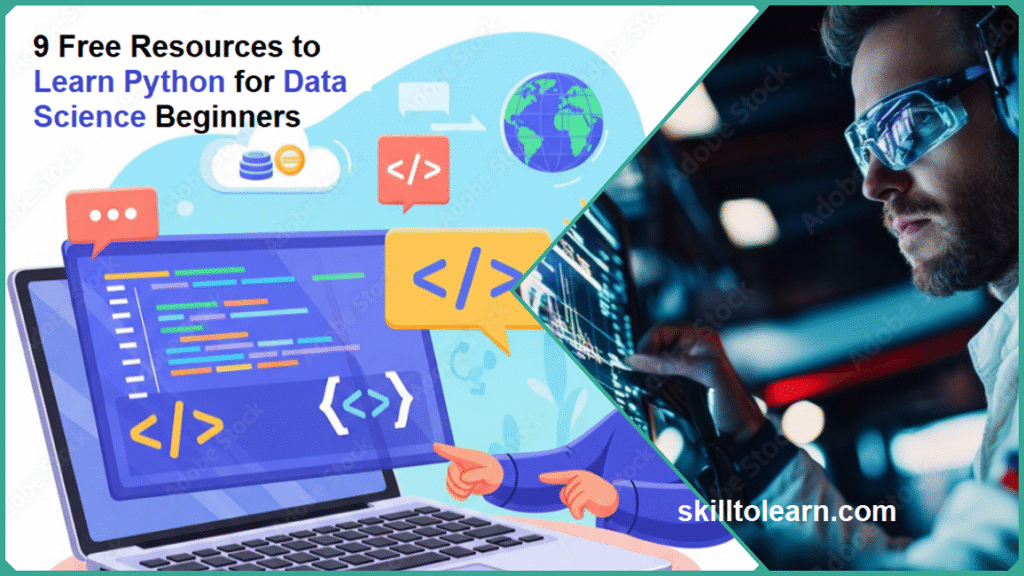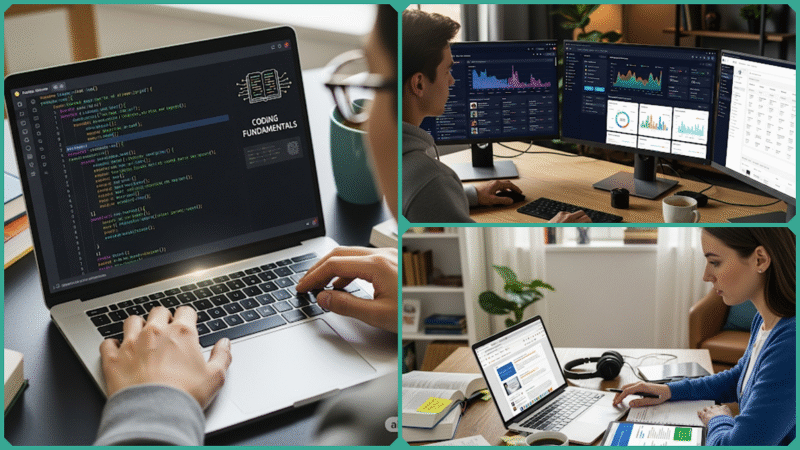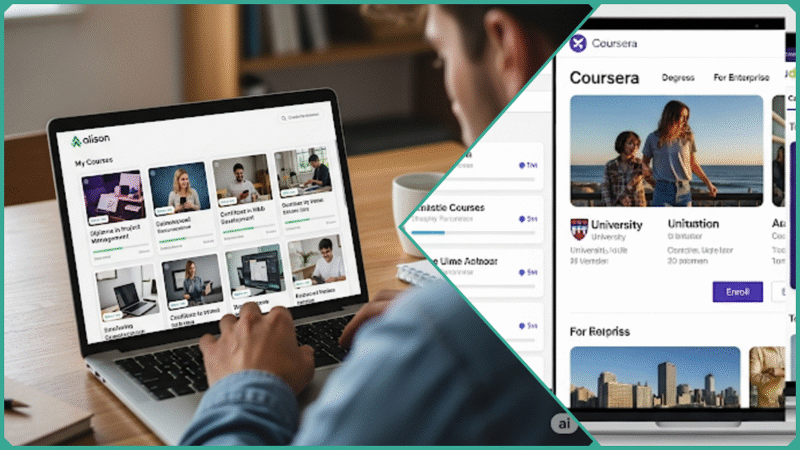9 Free Resources to Learn Python for Data Science Beginners
Estimated reading time: 30 minutes
Python has rapidly become the fundamental backbone supporting the entire data science revolution. Its remarkable simplicity, incredible flexibility, and extensive collection of powerful libraries make it the preferred and go-to programming language for analyzing complex data sets, building sophisticated predictive models, and extracting meaningful insights across a wide range of industries and applications.
However, for beginners who are just starting—especially those with absolutely no prior experience in programming—the vast and seemingly endless volume of available free resources to learn Python and other learning materials can feel incredibly overwhelming and difficult to navigate.
So, how do you determine the best place to start your learning journey?
Which resources are truly helpful and worth your time, and which ones might end up wasting your precious time and effort?

This comprehensive guide is thoughtfully crafted for complete beginners, aspiring data scientists, eager students, budget-conscious professionals, and motivated self-starters who are determined to break into the exciting field of data science using Python, without incurring any expenses. Within this guide, you will discover a carefully curated and well-organized list of the very best free resources available to learn Python effectively.
Additionally, you will find clear, structured explanations of essential key concepts, along with helpful answers to the most common questions that beginners often have. By the time you finish reading this guide, you will have a well-defined, actionable roadmap that empowers you to embark on your data science journey cost-effectively and efficiently, and confidently.
Why Python for Data Science?
Python has firmly established itself as the preferred programming language for data science, and this widespread popularity is far from coincidental. Its unique combination of simplicity, flexibility, and a robust ecosystem of libraries and tools makes it an exceptional choice for a wide range of users, from beginners taking their first steps in data analysis to experienced professionals tackling complex projects.
This exceptionally powerful and carefully crafted blend guarantees that Python will continue to hold its position at the very forefront of innovation and practical application within the rapidly evolving field of data science.
Key Reasons for Python’s Popularity in Data Science
- Readable and Beginner-Friendly Syntax
- Python’s syntax is clear and intuitive, closely resembling plain English.
- This readability lowers the barrier to entry, enabling beginners to quickly grasp programming fundamentals and focus on solving data problems rather than deciphering complex code structures.
- Rich Ecosystem of Libraries
- Python boasts a vast array of specialized libraries that streamline data science tasks:
- NumPy: Efficient numerical computing and array operations.
- Pandas: Powerful data manipulation and analysis tools.
- Matplotlib & Seaborn: Advanced data visualization capabilities.
- scikit-learn: Comprehensive machine learning algorithms and utilities.
- TensorFlow & PyTorch: Deep learning frameworks for advanced AI applications.
- Python boasts a vast array of specialized libraries that streamline data science tasks:
- These libraries are well-documented and widely used, ensuring robust community support and regular updates.
- Active and Supportive Community
- Python’s global community of developers, researchers, and educators actively contributes tutorials, forums, and open-source projects.
- Platforms like Stack Overflow, GitHub, and dedicated Python forums offer quick solutions to common challenges, making it easier for learners to overcome obstacles and advance their skills.
- Versatility Across Domains
- Python is not limited to data science; it’s used in web development, automation, scientific computing, and more.
- This versatility means skills learned in Python can be applied across a wide range of industries and roles.
- Industry Adoption
- Leading organizations such as Google, Netflix, NASA, and Facebook rely on Python for data analysis, machine learning, and decision-making processes.
- Python’s integration into enterprise workflows further validates its importance and ensures long-term career relevance for learners.
- Consistent Top Rankings
- According to the 2024 Stack Overflow Developer Survey, Python consistently ranks among the top languages for data science, machine learning, and overall developer preference.
- Its popularity translates to abundant job opportunities and a wealth of learning resources.
Quick Comparison: Python vs. Other Data Science Languages
| Feature | Python | R | Julia | Java |
|---|---|---|---|---|
| Syntax | Easy | Moderate | Moderate | Complex |
| Libraries | Extensive | Extensive | Growing | Limited (DS) |
| Community Support | Very Strong | Strong | Emerging | Strong |
| Industry Adoption | Widespread | Academic/DS | Niche | Enterprise |
| Learning Curve | Gentle | Moderate | Moderate | Steep |
Real-World Impact
- Beginner-Friendly: Python’s approachable syntax and supportive community make it the go-to language for those starting in data science.
- Professional Power: Its robust libraries and frameworks enable professionals to tackle complex analytics, machine learning, and AI challenges.
- Career Advantage: Mastery of Python opens doors to roles in data analysis, machine learning, artificial intelligence, and beyond.
Python’s unique combination of simplicity, power, and community support makes it the ideal language for anyone aspiring to enter or advance in the world of data science. Whether you’re analyzing data, building predictive models, or visualizing insights, Python provides the tools and resources needed to succeed.
Key Concepts and Theories for Learning Python in Data Science
Before you begin exploring various resources, it is essential to first grasp the foundational concepts that serve as the backbone of Python programming, specifically tailored for data science. Developing a strong understanding of these core ideas will significantly enhance your learning journey, making it much smoother and far more effective.
This solid foundation will empower you to confidently approach and solve real-world data challenges with greater ease and proficiency.
Variables and Data Types
Variables are containers for storing data values. In Python, you don’t need to declare the type of a variable explicitly; it’s inferred automatically. Data types are the classification of data items. The most common types you’ll encounter include:
- Integers: Whole numbers (e.g.,
5,-42) - Floats: Decimal numbers (e.g.,
3.14,-0.001) - Strings: Text data (e.g.,
"hello world") - Lists: Ordered, mutable collections (e.g., “)
- Dictionaries: Key-value pairs for fast lookups (e.g.,
{"name": "Alice", "age": 25})
Mastering variables and data types is fundamental because they serve as the essential building blocks for storing, retrieving, and manipulating all kinds of information within your programs. Understanding how to effectively use variables and data types allows you to manage the data your program works with, enabling more complex and meaningful operations.
Control Flow
Control flow statements give you the ability to control and direct the path your program follows depending on certain conditions and repeated actions. These statements enable your program to make decisions and execute specific blocks of code when particular criteria are met, or to repeatedly perform tasks until a condition changes. This capability is essential for creating dynamic and responsive programs that can handle a variety of scenarios efficiently.
- Conditional Statements: Use
if,elif, andelseto execute code blocks based on specific conditions. - Loops: Use for and while Loops to repeat actions, such as iterating over a list of data or performing calculations multiple times.
These fundamental constructs are essential for automating a wide range of tasks, efficiently processing large amounts of data, and building complex logic and decision-making capabilities into your code.
Functions
Functions are reusable blocks of code designed to perform specific tasks. They help organize your code, avoid repetition, and make programs easier to maintain.
- Defining Functions: Use the
defkeyword to create a function. - Arguments and Return Values: Functions can accept inputs (arguments) and return outputs (values).
In the field of data science, functions play an essential role by allowing practitioners to break down complex data operations into smaller, more manageable, and understandable steps. Functions help organize code efficiently, making it easier to perform repetitive tasks and maintain clarity throughout the data analysis process.
Libraries
Libraries are organized collections of pre-written code, functions, and tools that significantly extend and enhance Python’s built-in capabilities. They enable programmers to efficiently perform complex tasks without having to write code from scratch.
When it comes to data science, several key libraries are absolutely indispensable and widely used by professionals to analyze data, create visualizations, and build machine learning models. These libraries provide robust, optimized, and user-friendly functionalities essential for data-driven projects:
- NumPy: Enables efficient numerical computations and supports multi-dimensional arrays.
- Pandas: Provides powerful tools for data manipulation, cleaning, and analysis using DataFrames.
- Matplotlib & Seaborn: Allow for data visualization, making it easier to interpret and communicate results.
- scikit-learn: Offers a wide range of machine learning algorithms and utilities for model building and evaluation.
Using these libraries not only saves a significant amount of time but also enables you to take advantage of best-in-class, industry-leading solutions specifically designed to tackle common data science tasks efficiently and effectively.
Jupyter Notebooks
Jupyter Notebooks are interactive coding environments that combine code, text, and visualizations in a single document. They are widely used in the data science community for:
- Experimentation: Test and iterate on code snippets quickly.
- Documentation: Add explanations and notes alongside code.
- Visualization: Display charts and graphs inline for immediate feedback.
Jupyter Notebooks have become especially popular and widely used for sharing detailed analyses and collaborating effectively with others across various fields. Their interactive nature and user-friendly interface make them an ideal tool for teamwork and knowledge exchange.
Data Analysis Workflow
A typical data analysis workflow in Python generally includes several important and sequential steps that guide the entire process from raw data to actionable insights. These steps often start with data collection or acquisition, followed by thorough data cleaning and preprocessing to ensure the dataset is accurate and usable.
Next, exploratory data analysis (EDA) is conducted to uncover patterns, trends, and relationships within the data. After that, the workflow typically proceeds to feature engineering and selection to improve model performance. Finally, the process concludes with modeling, evaluation, and interpretation of the results to draw meaningful conclusions and support decision-making.
- Importing Data: Loading datasets from files (CSV, Excel, databases, APIs).
- Cleaning and Transforming: Handling missing values, correcting data types, filtering, and transforming data for analysis.
- Analyzing Patterns: Using statistical and exploratory techniques to uncover trends and relationships.
- Visualizing Results: Creating charts and graphs to communicate findings effectively.
Developing a clear understanding of this workflow is essential for effectively structuring your projects in a way that maximizes efficiency and clarity. It enables you to transform raw, unprocessed data into meaningful, actionable insights that can drive decision-making and strategic planning. By mastering this process, you ensure that every step from data collection to analysis is purposeful and contributes to achieving your project goals.
Summary of the Key Concepts and Theories for Learning Python in Data Science
| Concept | Description | Example Tools/Libraries |
|---|---|---|
| Variables & Data Types | Store and classify data | int, float, str, list, dict |
| Control Flow | Direct program logic with conditions and loops | if, else, for, while |
| Functions | Reusable code blocks for specific tasks | def, return |
| Libraries | Pre-written code for specialized tasks | NumPy, pandas, Matplotlib, scikit-learn |
| Jupyter Notebooks | Interactive environment for code, text, and visualizations | Jupyter Notebook |
| Data Analysis Workflow | Steps from data import to visualization | pandas, matplotlib, seaborn |
Grasping these essential key concepts will provide you with a strong and reliable foundation as you begin your exciting journey into Python for data science. Each topic carefully builds upon the previous one, creating a comprehensive learning path, so it is important to take your time to thoroughly understand and practice these foundational ideas before moving on to more advanced and complex material. This approach will ensure you develop a solid grasp and confidence in your skills.
The Best Free Resources to Learn Python for Data Science
For beginners eager to dive into Python for data science, selecting the right learning resources can be overwhelming. To help you get started efficiently, here is a curated list of free, high-quality resources tailored specifically for data science beginners.
Each one offers a distinct and unique learning style along with a specialized focus, allowing you to carefully choose the option that best matches your personal preferences and specific goals for learning and development.
| Resource | Format | Focus | Ideal For | Key Features |
|---|---|---|---|---|
| Codecademy: Learn Python 3 | Interactive Course | Python Basics | Absolute Beginners | Hands-on coding exercises, browser-based, self-paced |
| Coursera: Python for Everybody | Video Course | Python Fundamentals, Data Handling | Beginners, Career Changers | Taught by Dr. Charles Severance, practical assignments, free audit |
| Kaggle Learn | Micro-Courses | Data Science, Python, Pandas, Visualization | Project-Oriented Learners | Real-world datasets, instant feedback, and certificates |
| Dataquest: Data Scientist in Python Path | Interactive Path | Python, Data Analysis, Visualization | Structured Learners | Guided projects, browser-based, beginner-friendly |
| freeCodeCamp: Python for Beginners | YouTube Video | Python Programming | Visual/Auditory Learners | 4.5-hour video, project-based, no prior experience needed |
| LearnPython.org | Interactive Tutorial | Python Basics to Advanced | Self-Paced Learners | In-browser coding, step-by-step lessons, and community support |
| HarvardX: CS50’s Introduction to Programming with Python | Online Course | Programming Fundamentals | Academic Learners | Rigorous, university-level, free access |
| Python Institute: Python Essentials 1 | Online Course | Python Certification Prep | Certification Seekers | Beginner-friendly, prepares for the PCEP exam |
| freeCodeCamp: 12-Hour Python Data Science Course | YouTube Video | Python, Pandas, NumPy, Matplotlib | Data Science Beginners | Covers basics to visualization, hands-on, full codebase provided |
Detailed Overview of Top Free Resources
Codecademy: Learn Python 3
Codecademy provides a highly interactive, browser-based course designed to teach Python fundamentals, including essential concepts such as variables, loops, and functions. This course features numerous hands-on exercises that are especially suited for absolute beginners who gain the most understanding through active practice and direct engagement with the material.
The free version of Codecademy offers a robust foundation and valuable practical coding experience, all without requiring any complicated software installation or setup, making it an accessible and convenient choice for new learners.
Coursera: Python for Everybody
Taught by the well-known Dr. Charles Severance, this course provides a thorough introduction to the Python programming language and essential data handling techniques. It includes engaging video lectures, interactive quizzes, and carefully designed assignments that help to reinforce and deepen your understanding of the material.
You have the option to audit the entire course for free, which makes it highly accessible to learners who are interested in gaining structured and high-quality content from a reputable and experienced educator in the field.
Kaggle Learn
Kaggle’s micro-courses are specifically designed to help learners apply Python programming skills to a variety of real-world data science problems and scenarios. Through these courses, you will gain practical experience using powerful tools like pandas for efficient data manipulation, as well as techniques for visualizing data to uncover meaningful insights.
Additionally, you will learn how to build simple yet effective predictive models. The platform offers instant feedback on exercises and projects, which helps reinforce learning quickly. Coupled with active community forums where you can ask questions, share ideas, and collaborate, Kaggle’s micro-courses provide an ideal learning environment for individuals who thrive on project-based and hands-on learning approaches.
Dataquest: Data Scientist in Python Path
Dataquest provides an engaging and interactive, step-by-step learning path that takes you from fundamental Python programming concepts through to advanced data analysis and visualization techniques.
It’s an entirely browser-based environment that removes any need for complicated software installations or setup, making it incredibly accessible for learners of all levels. The curriculum is thoughtfully designed to focus on hands-on projects that help you build a strong portfolio, which is a critical asset for anyone looking to secure a job in the data science field.
freeCodeCamp: Python for Beginners
This comprehensive 4.5-hour YouTube video course is carefully project-based and specifically designed to cater to both visual and auditory learners. It thoroughly covers the fundamentals of Python programming and incorporates a variety of practical, real-world examples and exercises to help beginners understand and grasp key programming concepts more quickly and effectively.
LearnPython.org
An interactive tutorial platform designed to cover a wide spectrum of Python topics, ranging from beginner-level fundamentals to more advanced programming concepts. The platform is entirely self-paced, allowing learners to progress at their own speed without any time constraints.
It features in-browser coding exercises that enable users to practice coding directly within the platform, enhancing hands-on learning. This setup makes it particularly accessible and convenient for individuals who prefer independent study while still benefiting from the support and interaction of an engaged community.
HarvardX: CS50’s Introduction to Programming with Python
This comprehensive university-level course offers a rigorous and detailed introduction to the fundamental principles of programming by using the Python language. It is specifically designed for learners who are looking for a structured academic approach and wish to gain a deeper, more thorough understanding of core programming concepts and techniques.
Python Institute: Python Essentials 1
This free online course is designed to thoroughly prepare learners for the Python Certified Entry-Level Programmer (PCEP) exam. It is specifically tailored for beginners and offers a well-organized, step-by-step path to achieving certification. Successfully earning this certification can significantly boost your resume and improve your job prospects in the programming field.
freeCodeCamp: 12-Hour Python Data Science Course
This comprehensive and detailed YouTube course thoroughly covers Python basics, essential data manipulation techniques using the pandas library, advanced numerical computing with NumPy, and effective visualization methods with Matplotlib.
It is designed to be highly hands-on, providing practical examples and exercises, and it includes a complete codebase for learners to practice along with. This makes it an excellent all-in-one resource for anyone looking to build a strong foundation and gain practical skills in data science and programming.
Additional Tips for Choosing Resources
- Match your unique learning style: Interactive courses such as Codecademy and Dataquest are especially beneficial for learners who thrive on hands-on experience and active participation. On the other hand, video-based courses like freeCodeCamp and Coursera are ideal for individuals who prefer structured, guided instruction and enjoy following along with visual and auditory explanations. Choosing the right platform based on how you learn best can significantly enhance your understanding and retention of the material.
- Look for project-based content: Engaging in hands-on projects that apply key concepts not only solidifies your understanding but also helps you develop practical skills. Working on real-world projects allows you to reinforce what you’ve learned in a meaningful way while creating a portfolio that showcases your abilities and achievements to potential employers or clients. This approach makes learning more interactive and impactful.
- Use community forums: Platforms such as Kaggle and LearnPython.org provide extensive community support, which proves to be incredibly valuable not only for troubleshooting various issues but also for maintaining motivation throughout your learning journey. These forums allow you to connect with like-minded individuals, share your progress, ask questions, and receive feedback, creating a supportive environment that fosters continuous growth and problem-solving.
- Consider certification: If you are seeking formal recognition for your skills and knowledge, pursuing certification can be highly beneficial. Courses such as the Python Institute’s Essentials 1 or obtaining a paid certificate through platforms like Coursera provide credible validation of your expertise. These certifications not only enhance your resume but also demonstrate your commitment and proficiency to potential employers or clients.
Supplementary Resources
- GeeksforGeeks Data Science with Python Tutorial: Provides comprehensive and detailed guides covering essential Python libraries such as pandas, NumPy, and Matplotlib, along with in-depth explanations of various data preprocessing techniques used in data science projects.
- DataCamp Blog on Python Libraries: Provides a detailed explanation of the critical role that essential Python libraries such as NumPy and scikit-learn play in enhancing and streamlining data science workflows. It highlights how these libraries serve as foundational tools that empower data scientists to efficiently manipulate data, perform complex numerical computations, and implement machine learning algorithms, thereby facilitating more effective and accurate data analysis.
- Rivery Blog: Explores in detail the numerous advantages of using interactive and video-based courses, especially designed for beginners who are starting to learn Python programming. It highlights how these dynamic learning methods can significantly enhance understanding and retention of Python concepts.
By taking full advantage of these completely free resources, beginners are empowered to confidently begin their Python for data science journey, gradually building essential skills that are highly sought after and valued in today’s rapidly evolving and competitive data-driven job market.
Current Trends and Developments in Learning Python for Data Science
The landscape of learning Python for data science is evolving at an incredibly rapid pace, driven by continuous technological innovation, shifting learner preferences, and the ever-changing demands of the modern workforce.
These factors combine to create a dynamic environment where new methods and tools for learning emerge regularly. Here are some of the most significant trends currently shaping how beginners approach Python and data science in today’s fast-moving world:
- Interactive and Project-Based Learning: Modern educational platforms have shifted from passive, lecture-based content to interactive, hands-on learning. This approach empowers learners to:
- Experiment in Real Time: Platforms like Jupyter Notebooks and browser-based coding environments allow you to write, test, and visualize code instantly. This immediate feedback loop is proven to boost retention and build confidence.
- Work on Real Projects: Courses now emphasize building small, practical projects—such as data visualizations, simple analyses, or basic machine learning models—that mirror tasks performed by professional data scientists.
- Learn by Doing: Studies have shown that active engagement and project-based learning significantly improve understanding and long-term mastery, especially for technical subjects like programming and data science.
- Community Support and Peer Learning: The rise of community-driven learning is transforming how beginners progress:
- Active Forums and Peer Groups: Many platforms integrate discussion boards, Slack channels, or Discord servers where learners can ask questions, share solutions, and collaborate on projects.
- Mentorship and Feedback: Peer review systems and mentorship opportunities help learners receive constructive feedback and avoid common pitfalls.
- Real-World Collaboration: This mirrors the collaborative nature of data science in industry, where teamwork and communication are essential for success.
- Micro-Credentials and Certificates: While the core learning resources remain free, there is increasing value placed on optional paid certificates and micro-credentials:
- Resume and LinkedIn Boost: Earning a certificate from a recognized platform (such as Coursera, Dataquest, or Kaggle) can help you stand out in a competitive job market.
- Verified Skills: Micro-credentials signal to employers that you have completed rigorous coursework and demonstrated practical abilities.
- Stackable Learning: Many platforms now offer modular, stackable credentials that can be combined into larger qualifications over time.
- Focus on Real-World Data: To ensure learners gain job-ready skills, courses increasingly use authentic, real-world datasets:
- Industry-Relevant Examples: Datasets from healthcare, finance, social media, and government sources expose learners to the types of data they’ll encounter in professional roles.
- Practical Problem Solving: Working with messy, complex data teaches valuable skills in data cleaning, feature engineering, and exploratory analysis.
- Portfolio Development: Completing projects with real data allows learners to build a portfolio that showcases their abilities to potential employers.
The most effective and popular free resources available today for learning Python specifically for data science now place a strong emphasis on interactivity, active community engagement, earning recognized credentials, and gaining hands-on practical experience with real-world datasets.
These current trends not only make the learning process significantly more engaging and accessible to a wider audience but also help ensure that beginners develop the skills and knowledge necessary to meet the complex demands of modern data-driven careers in a competitive job market.
How to Structure Your Learning Path for Python in Data Science
To maximize your learning efficiency and successfully build a strong, solid foundation in Python specifically tailored for data science, it is crucial to follow a clear, logical, and step-by-step progression throughout your study process.
This well-structured approach ensures that you thoroughly understand and grasp the fundamental concepts first, which then prepares you to confidently move on to more advanced topics and practical, real-world applications in data science.
Here’s a recommended learning path based on expert guidance and proven curricula from leading platforms:
- Start with Python Basics: Variables, data types, control flow (if/else, loops), and functions.
- Why: These are the core building blocks of any programming language. Mastering them ensures you can write and understand Python code effectively.
- Recommended Resources:
- Codecademy: Learn Python for Data Science Skill Path (includes hands-on practice with real datasets and Jupyter Notebook)
- LearnPython.org (interactive tutorials for beginners)
- freeCodeCamp: Python for Beginners YouTube course (project-based, beginner-friendly)
- Move to Data Structures and Libraries: Lists, dictionaries, and essential Python libraries like NumPy and pandas.
- Why: Data structures enable you to organize and manipulate data efficiently. Libraries like NumPy and pandas are fundamental for numerical computing and data manipulation in data science.
- Recommended Resources:
- Dataquest: Data Scientist in Python Path (guided projects with pandas and NumPy)
- Kaggle Learn micro-courses (practical exercises with real-world datasets)
- GeeksforGeeks Data Science with Python tutorial (comprehensive basics and libraries)
- Practice Data Analysis and Visualization: Analyzing datasets, cleaning data, and visualizing insights using Matplotlib or Seaborn.
- Why: Visualization helps you interpret data and communicate findings effectively. Practicing on real datasets builds confidence and practical skills.
- Recommended Resources:
- Kaggle Learn (data visualization courses)
- freeCodeCamp: 12-Hour Python Data Science Course (covers Pandas, NumPy, and Matplotlib)
- Real Python tutorials on pandas and visualization
- Explore Machine Learning Foundations: Basic machine learning algorithms, model building, and evaluation using scikit-learn.
- Why: Machine learning is a key component of data science. Understanding foundational algorithms prepares you for more advanced topics.
- Recommended Resources:
- HarvardX: Introduction to Data Science with Python (includes regression, classification, and sklearn)
- Dataquest and Udemy beginner courses on Python for machine learning fundamentals
- Coursera: Python for Everybody (for foundational skills before ML)
- Build a Portfolio: Complete guided projects and showcase your work on platforms like GitHub or Kaggle.
- Why: A portfolio demonstrates your practical skills to potential employers and helps consolidate your learning.
- Recommended Actions:
- Use projects from Codecademy, Dataquest, or freeCodeCamp as portfolio pieces
- Participate in Kaggle competitions or dataset challenges
- Share your notebooks and code on GitHub with clear documentation
Summary of participating in Kaggle competitions or dataset challenges
| Stage | Topics Covered | Recommended Resources |
|---|---|---|
| Python Basics | Variables, control flow, functions | Codecademy, LearnPython.org, freeCodeCamp |
| Data Structures & Libraries | Lists, dictionaries, NumPy, pandas | Dataquest, Kaggle Learn, GeeksforGeeks |
| Data Analysis & Visualization | Data cleaning, Matplotlib, Seaborn | Kaggle Learn, freeCodeCamp, Real Python |
| Machine Learning Foundations | scikit-learn, regression, classification | HarvardX, Dataquest, Udemy |
| Portfolio Building | Projects, GitHub, Kaggle competitions | Codecademy projects, Kaggle, GitHub |
Practical Tips
- Set consistent goals: Dedicate a specific and regular amount of time each week to study and practice, ensuring that your learning routine becomes a steady and reliable part of your schedule. This consistent commitment will help reinforce your skills and knowledge over time.
- Apply as you learn: Actively engage in working on small projects and practical exercises to thoroughly reinforce and deepen your understanding of the concepts being taught. This hands-on approach helps solidify your knowledge and enhances your learning experience.
- Engage actively with various communities by joining popular forums such as Stack Overflow, Kaggle, or Reddit’s r/datascience. These platforms provide excellent opportunities for learning, sharing knowledge, and receiving valuable support from fellow data science enthusiasts and professionals. Participating in discussions, asking questions, and contributing your insights can greatly enhance your understanding and help you solve challenges more efficiently.
- Document your journey: Consistently maintain a GitHub repository or a personal blog to thoroughly track your progress, reflect on your learning experiences, and effectively showcase your growing skills and projects to potential employers or collaborators.
Following this carefully structured and thoughtfully designed path will significantly help you build strong confidence, acquire a wide range of valuable and marketable skills, and thoroughly prepare yourself for a successful and rewarding career in the rapidly growing field of data science using Python.
Real-World Example: From Beginner to Data Analyst
Consider the inspiring journey of Priya, a determined university student who started with absolutely no prior experience in coding but harbored a strong aspiration to become a skilled data analyst. Her story vividly illustrates how access to free, well-organized, and carefully structured learning resources can empower complete beginners like her to develop valuable, marketable skills.
Within just a few months, Priya was able to confidently build a solid foundation in data analysis and successfully launch her career in the competitive field of data science.
Building a Strong Foundation with Codecademy
Priya began her comprehensive learning journey by enrolling in Codecademy’s free Python course, choosing to follow the Data Scientist: Machine Learning Specialist career path. This well-structured course introduced her not only to the fundamental concepts of Python programming but also to important data literacy principles that are crucial for data science.
Additionally, she gained practical experience with essential Python libraries such as pandas and scikit-learn, which are widely used in data manipulation and machine learning tasks.
Through a combination of hands-on exercises and engaging real-world projects, including detailed analysis of U.S. medical insurance data, Priya developed a strong and thorough understanding of Python programming as well as the foundational skills needed for effective data manipulation and analysis.
Deepening Skills with Dataquest’s Guided Projects
To gain a deeper and more practical understanding of data science, Priya decided to advance her learning by enrolling in Dataquest’s comprehensive Data Scientist in Python learning path. This innovative platform offered highly interactive, browser-based lessons that enabled her to engage directly with authentic, real-world datasets.
Through this hands-on approach, she was able to effectively apply powerful Python libraries such as NumPy, pandas, and Matplotlib in a variety of contexts. Additionally, Dataquest’s carefully designed guided projects mimicked realistic business scenarios, providing Priya with invaluable experience.
These projects allowed her to systematically develop and showcase a robust portfolio of work, clearly demonstrating her growing expertise in data cleaning, thorough data analysis, and insightful data visualization techniques.
Applying Knowledge Through Kaggle Competitions
Eager to test and expand her skills in a highly competitive environment, Priya enthusiastically began participating in various Kaggle competitions and engaging with numerous micro-courses offered on the platform. Kaggle’s comprehensive platform provided her with carefully curated datasets alongside practical, hands-on challenges that significantly reinforced and deepened her learning experience.
By working directly with real-world data, she was able to sharpen and refine her abilities in critical areas such as data exploration, feature engineering, and building predictive models. Additionally, the certificates she earned from completing Kaggle’s free courses served as valuable credentials, further validating and showcasing her skills to potential employers and helping her stand out in the job market.
Outcome: Securing a Data Analyst Internship
Within a dedicated period of six months filled with consistent learning efforts and hands-on project work, Priya’s portfolio grew to showcase a diverse range of practical and impactful data science projects. These projects spanned from essential tasks such as data cleaning and visualization to more advanced challenges like predictive modeling.
This clear and tangible demonstration of her growing skills and knowledge played a crucial role in helping her secure an internship as a data analyst. This achievement marked a significant and successful transition for Priya, moving from being a complete beginner in the field to becoming an industry-ready professional fully prepared to contribute effectively.
Key Takeaways from Priya’s Journey
- Start with basics: Codecademy’s Python courses built a solid foundation.
- Learn actively: Dataquest’s projects turned theory into hands-on skills.
- Work with real data: Kaggle contests offered genuine datasets and challenges.
- Create a portfolio: Sharing projects on GitHub or Kaggle boosts job prospects.
- Use free tools: Quality free resources can speed career growth without costs.
Priya’s experience serves as a powerful example of how highly motivated learners can successfully leverage a wide range of free resources to effectively develop valuable and in-demand data science skills.
By taking full advantage of these accessible learning materials, she was able to significantly enhance her knowledge and expertise, which ultimately helped her open doors to numerous exciting and rewarding career opportunities in the competitive field of data science.
FAQs
Do I need math or programming experience to start learning Python for data science?
No prior experience is required. Most beginner courses, such as Codecademy’s Learn Python for Data Science path, start from the basics and assume zero background in programming or math. However, a strong willingness to practice regularly and solve problems is essential to succeed in learning Python and data science.
Which Python library should I learn first for data science?
Start with pandas, which is essential for data manipulation and analysis. Then explore NumPy for numerical operations and Matplotlib for data visualization. These libraries form the core toolkit for most data science workflows and are covered extensively in free courses like freeCodeCamp’s Python Data Science course and Kaggle Learn micro-courses.
How much time does it take to learn Python for data science?
With consistent effort—about 5 to 10 hours per week—you can grasp the basics in 1 to 2 months. Building confidence by working on real projects and datasets may take 3 to 6 months, depending on your pace and prior experience. Platforms like Codecademy estimate around 16 hours to complete their beginner skill paths, but real mastery comes with practice and project work.
Are free resources as good as paid courses or bootcamps?
Absolutely. Many free resources are created by leading universities and industry experts. For example, HarvardX’s Introduction to Data Science with Python and Coursera’s Python for Everybody are university-level courses available for free audit. The key is to choose structured, reputable materials and dedicate time to consistent practice. Free resources often include hands-on projects and community support comparable to paid options.
How can I stay motivated and track my progress?
- Set small, achievable goals: For example, complete one lesson or project per day.
- Join online communities: Engage with forums on platforms like Kaggle, Stack Overflow, or Reddit’s r/datascience to ask questions and share progress.
- Document your work: Use GitHub or a personal blog to showcase projects and track your learning journey.
- Celebrate milestones: Recognizing small wins keeps motivation high and helps build a portfolio that impresses employers.
In Conclusion
Learning Python for data science doesn’t have to be costly or overwhelming at all. By using the right free resources combined with a well-organized, clear, and structured learning path, along with a bit of dedication and perseverance, anyone can successfully acquire the essential skills needed to excel and thrive in a data-driven career.
Whether you are a student just beginning your educational journey, a professional aiming to upskill and expand your expertise, or simply someone curious about exploring the world of data science, these easily accessible tools and courses provide you with the opportunity to start your learning adventure without facing any financial obstacles or barriers.
Key Takeaways:
- Python remains the top language for data science due to its simplicity, readability, and an extensive ecosystem of powerful libraries like pandas, NumPy, Matplotlib, and scikit-learn.
- There are free, high-quality resources available for every learning style and background, including interactive courses, video tutorials, and project-based platforms like Codecademy, Coursera, Kaggle, and Dataquest.
- Following a structured approach—starting from Python basics, moving to data manipulation and visualization, and then exploring machine learning—yields the best results and builds confidence.
- Community support and real-world practice through forums, competitions, and portfolio projects are crucial for long-term success and employability.
- Leveraging free certificates and micro-credentials can boost your resume and showcase your skills to potential employers.
Are you ready to begin and take the first exciting step forward?
Choose one resource from the carefully curated list provided above, set your very first learning goal with intention, and become part of the vibrant global community of dedicated data science learners. Your exciting journey toward becoming a highly skilled and proficient Python data scientist officially begins today, opening doors to countless opportunities and new knowledge!
If you found this guide helpful and insightful, we encourage you to explore a wide range of additional skill-building content available on skilltogrow.com. Don’t forget to subscribe to our newsletter to receive the latest updates, tips, and exclusive resources directly in your inbox. We also invite you to share your personal learning experiences, thoughts, and feedback in the comments section below to join the community and help others on their growth journey!






